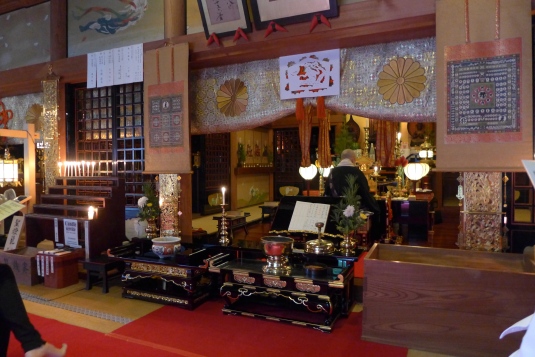Obon. Hungry Ghost Festival. Pitru Paksha.
Summer happened and Autumn is right around the corner. This time forms a melancholic, yet beatiful transition for me. At the peak of summer, fireworks take to the skies with an air of festivities as people walk about in Yukatas. Then, just as it gets a little too hot, the skies begin to darken rain greets the overheated pavments. The trees begin to yellow. Slowly but surely, Autum arrives like a regal creature with its yellow, red and orange shades. The air, no longer muggy hot, is crisp with a slight smokey smell.
At the peak of its blistering heat, Japan remembers its dead through Obon. During a 3 day period (13 July to 15 August), people go back to their hometowns and visit thier family graves. Summer is also considered to be a great time to tell ghost stories because as one friend told me, ghost stories make a person shiver (with fear) helping to beat the summer heat. I can’t vouch for the legitimacy of that statement, but it sounded interesting.
Here’s a short write up about Obon:
http://www.japan-guide.com/e/e2286.html
In China, Hong Kong, Taiwan, Malaysia, Singapore and Vietnam, during the 7th Month of the Lunar calander (this year it was from 03 Aug 2016 to 31 Aug 2016), there’s the Hungry Ghost Festival when Buddhist or Taoist people of Chinese descent would try to appease “Hungry Ghosts” that have left the realm of the dead to visit the world of the living. You can see people buring offerings for thier ancestors (including paper ferraris and Iphones), Getai and Chinese Opera. There are also a list of dos and don’ts during this period, to avoid offending the ghosts. Not surprisingly, there are links between Hungry Ghost and Obon.
Here’s a nice reliable website on how we do this back home in Singapore:
http://www.yoursingapore.com/festivals-events-singapore/cultural-festivals/hungry-ghost-festival.html
In my own Hindu belief, we have Pitru Paksha. A series of rituals are to be followed over a 15 day period following the lunar calender ( this year it was from 16 September 2016 to 30 September 2016) to honor our ancestors every year. The eldest son of the family is usually responsible for doing the prayers.
Here’s good old wiki if you wanna read more on that:
https://en.wikipedia.org/wiki/Pitru_Paksha
So why talk about this?
Personally, I’m really interested in finding similarities between different cultures and my own. Often times, I’m enthralled to find how intertwined Asian cultures are despite the differences. The more I read, the more I find the influences and connections. It’s fascinating.
So, recently, I went to Mount Koya in Wakayama with my mom and stayed in a Shingon Buddhist temple called Fudoin. For anyone interested, this is an actual thing in Japan where you can stay at some Buddhist temple. It’s called Shukubo! You can even choose to have temple cuisine which are strictly vegetarian!
For more info on Shukubo:
http://eng.shukubo.net
Anyway, I stayed at this temple and I found out they did prayers every morning for the deceased. So, I asked my mom if she wanted to do any prayers for my paternal grandfather. Co-incidentally, our travel dates were during Pitru Praksha and the prayer date would also be the date designated specifically for my grandfather’s prayers. It was very emotional for mom.
So we submitted my grandfather’s name, his date of passing and my father’s name (he’s the firstborn son).
The next morning, we reported to the prayer room at 7am.

The head priest was already there. Once everyone was gathered, the prayers started. What followed, I find it hard to put it into words because of how mesmerising it was.
The morning prayers sounded like this:
https://www.youtube.com/watch?v=7VGeZDpaDdg
I really could have gone on and on listening to this. It really was an experience that left me much calmer and relaxed. Then they said a prayer in our name and as a group we read a part of the Hannya Shingyo (Heart Sutra). Lastly, the head priest said some words about the temple and Mount Koya’s history.
It all lasted for about 50 minutes.
After breakfast, we visited Okunoin where the founder of Mount Koya, Kobo Daishi is enshrined. The lead up to the main shrine houses Japan’s biggest cemetery (More than 200,000 graves!). When we reached the main shrine, morning prayers were underway. We were really lucky because the priests were performing a Goma (fire ritual, Homa, Yajna) in addition to the prayers…which was particularly touching to watch, because that’s what my name, Yagnya, means.
To watch the meaning of a Sanskrit name of a Singaporean Indian Girl being performed in a Shingon Buddhist temple in the mountains of Wakayama. I don’t know if I can ever put that into words for anyone.
We couldn’t take pictures inside, but here’s a video of a Goma being performed at another temple in Mount Koya:
https://www.youtube.com/watch?v=–A-5Dxmf74
And here’s a wiki article about Yajnas and their significance in Hinduism:
https://en.wikipedia.org/wiki/Yajna
…
I find myself floundering for last words here. I could say something like “we’re all equal in death…” but that would cheapen this entire experience.
So instead, I encourage you too to embark on your own journey in Japan to find something here that connects to you across borders and religion…that despite it all you find it sacred. It doesn’t mean you change your religion or become suddenly religious for this, just something that you find something that inexplicably connects to you on a deep personal level even if you are far far from home.
Recent Comments